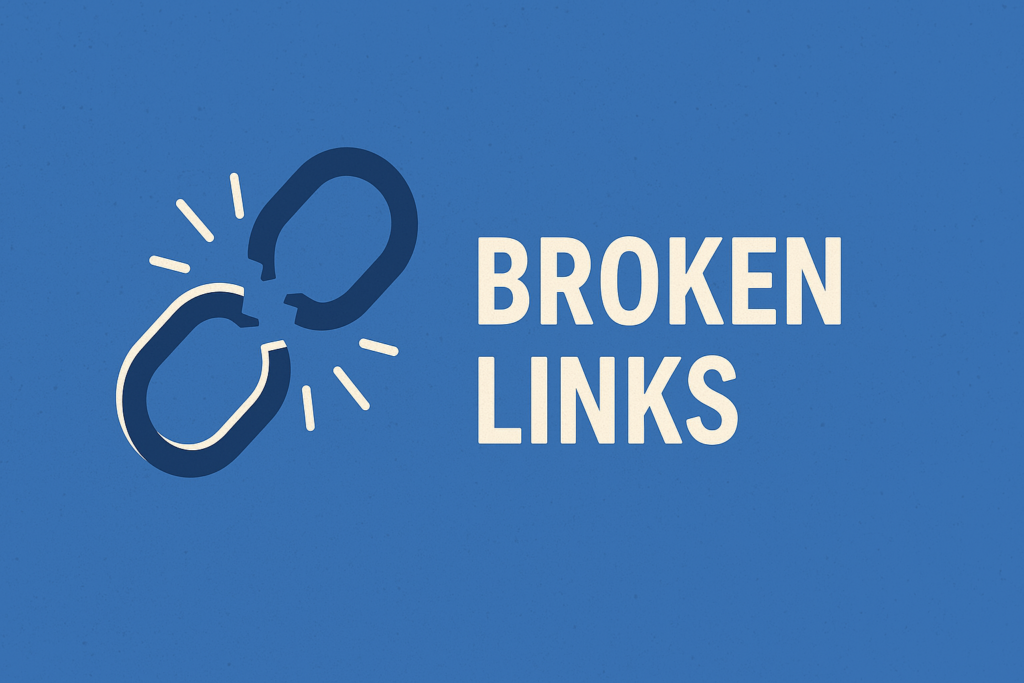
Links are an essential part of the internet. They help us navigate to different pages and websites. However, sometimes links break. This can be for various reasons, such as when a website is taken down or moved. When this happens, it’s called a broken link. Broken links can cause all sorts of problems for your website, from decreased traffic to lower search engine rankings.
This article, will discuss what are broken links, why they occur, and why fixing them is essential. We’ll also provide tips on finding and resolving smashed links on your website.
So, let’s get started with defining links.
What Are Links?
Links, also known as hyperlinks, are clickable elements on a webpage that redirect you to another page or website. They can be text, images, or buttons.
What Are Broken Links?

A broken link, also known as a dead link or a 404 error (named after the error code it produces), is a link that no longer successfully redirects a user to the intended webpage or website. This can happen for various reasons, such as when a website is taken down or moved without updating the link, resulting in an error page.
Types Of Broken Links:
There are two types of broken links:
- A broken internal link is a broken link on your website.
- A smashed external link is a smashed link on someone else’s website that links to yours.
Reasons Why Links Get Broken
- The linked website was deleted or moved without updating the link.
- The linked website was redesigned, causing the URL structure to change.
- A typo in the original link.
- The linked website is temporarily down for maintenance or experiencing technical issues.
- The linked page has been removed or moved within a website, but the link was not redirected accordingly.
List Of Things That Broken Links Can Have An Impact On
User Experience
User experience is the most apparent impact of smashed links. When a user clicks on a link and is directed to an error page, it can be frustrating and may lead them to leave your website. This can also affect your bounce rate, as users quickly leave your website.
Search Engine Rankings
Search engines like Google use links to crawl and index websites. Smashed links can result in search engines being unable to access certain pages on your website, leading to lower rankings.
Content Credibility
If a website contains broken links, it can make the website appear outdated or unreliable to users. It can also make your content seem less credible, as it may lead users to question the accuracy of information.
Bounce Rate
As mentioned before, smashed links can lead to a higher bounce rate as users leave your website due to frustration or a lack of trust in the website. This can harm your website’s overall traffic and conversions.
Note: What is the bounce rate?
Bounce rate is the percentage of visitors who enter a website and leave without taking any further action, such as clicking on other pages or making a conversion.
Link-Building Efforts
Broken external links can also hurt your link-building efforts. If another website links to a broken page on your website, it can harm the credibility and trust of that website. This can also result in lost opportunities for links and traffic.
Thus, it’s essential to regularly check for and fix any smashed links on your website.
Methods To Find Broken Links On Your Website
There are several methods you can use to find broken links. But here, we will mention three methods to help you quickly find your smashed links.
3 Methods Are As Follows:
Google Search Console
The first method is using Google Search Console. This tool will show you any broken links, or 404 errors, on your website that Google.
To find this information, log into your Google Search Console account and go to the “Coverage” section. “There, you will be able to see a list of smashed links on your website. Click on the “Excluded” tab and select “Not found.”
Screaming Frog
Another method is using a tool called Screaming Frog. This tool specializes in finding broken links, as well as other website issues. Enter your website’s URL and let the tool crawl your website to find any smashed links.
This tool has both versions, i.e., free and paid versions. To use this tool, you will need to download it onto your computer. A free version allows you to crawl up to 500 URLs simultaneously. Once the website has crawled your pages, you can go to the “Response Codes” tab to see a list of broken links.
Manually Checking Links
You can also manually check for broken links on your website. Go through each page and click on any. If the link redirects you to an error page, you have found a broken link. This method is only practical for smaller websites with a limited number of pages.
While this method may take more time, it is the most accurate way to find broken links on your website. You can also use various online tools to help you with this process.
Google’s Comment On Broken links
The “Help” section of Google Search Console states: “If your site has broken links, fix them by either updating or removing the pages that return a 404 status code.” Google recommends fixing smashed links as soon as possible to improve the overall user experience and search engine rankings.
Google also recommends redirecting smashed links to relevant and updated pages on your website. This way, you can still provide valuable information to the user and prevent them from leaving your website.
How To Resolve Broken Links?
Once you have found your broken links, what do you do?
The first step is to identify the cause of the broken link. Is it a deleted or moved website? A typo in the original link? If the issue is a typo, correct the link.
- If the linked website has been deleted or moved, try to find an updated link or replace it with a different relevant link.
- If the linked page has been removed or moved within your website, redirect the link to a relevant, updated page. This can be done by setting up 301 redirects.
FAQs
Q. How Often Should I Check For Broken Links On My Website?
It is recommended to regularly check for broken links, at least once every few months. But always keeping an eye on your website’s links and fixing them as they come up is ideal.
Q. Can Broken Links Harm My Website’s Search Rankings?
Yes, broken links can harm your website’s search rankings as they can disrupt the user experience and prevent search engine crawlers from adequately indexing your pages.
Q. Is It Necessary To Fix All Broken Links?
It is essential to fix any smashed links that may impact the user experience or search rankings. However, if the broken link is on a less critical page or has little impact, it may not be necessary to fix it immediately.
Final Thoughts
Overall, checking for and fixing broken links on your website is essential. Utilize the methods and tools mentioned above to find and resolve any smashed links on your website effectively. This can enhance the user experience and improve your website’s search rankings.
Suppose you have any questions related to broken links. Then feel free to leave your questions in the comment section. We will be happy to answer you.
Thanks for reading:)


